Determination of TPH and PAH Contaminants Levels in Selected Ready-To-Eat Foods in Southern Nigeria
| Received 27 Mar, 2024 |
Accepted 31 May, 2024 |
Published 31 Dec, 2024 |
Background and Objective: The quality of ready-to-eat-foods (RTEFs) sold around traffic-congested areas in our cities has been a serious public health concern in recent times. The level of some contaminants in some RTEFs (rice and stew, roasted plantain, melon soup, as well as cake and meat pie snacks) sold at selected traffic-congested areas in three major cities in South-South (Port Harcourt, Calabar and Yenagoa), Nigeria was assessed. Materials and Methods: The food samples were collected, between 12 noon and 2 pm, when patronage is assumed to be high, wrapped in aluminum foil at three randomly selected traffic-congested areas in Port Harcourt (PH), Calabar and Yenagoa. The samples were treated with standard methods and were subjected to hydrocarbon analyses using standard methods and procedures. Results: The results showed that the total hydrocarbon content in roasted plantain from Calabar and PH was significantly (p<0.05) higher than the level in Yenagoa products. Also, the total hydrocarbon level in snacks and soup from PH was significantly (p<0.05) higher than the level in the same products from Calabar and Yenagoa, while the level in rice and stew from Calabar and Yenagoa was significantly (p<0.05) higher than the level in PH product. These results suggest that the quality of most RTEFs along our traffic-congested areas in the cities is not safe; thereby leaving cause for serious public health concerns. Conclusion: It may be concluded that the quality of most RTEFs vendors in our traffic-congested areas in the cities is not safe. Thereby leaving cause for serious public health concerns in food safety.
INTRODUCTION
The quality of ready-to-eat-foods (RTEFs) sold around traffic-congested areas in our cities has been a serious public health concern in recent times. The Food and Agriculture Organization defines street foods as ready-to-eat (RTE) foods and beverages prepared and/or sold by vendors and hawkers, especially alongstreets and other similar public places1. The RTE foods are also described as foods that can be bought directly from street vendors or hawkers and consumed at the point of sale or at a later time without further processing2. The RTE foods are therefore those foods that are considered to be ready for immediate consumption at the point of sale.
Most of these RTE foods are relatively cheap and readily accessible3. The RTE foods are in most cases sold along streets and are therefore known to play important role in the feeding pattern of different categories of people in both urban and rural societies.
Hawking of food products in traffic-congested areas and around petrol stations has been a common practice in several cities. An estimated 2.5 billion people have been reported to patronize RTE food vendors worldwide4. The consumption of street foods, including RTE foods, has been suggested to potentially increase the risk of food-borne diseases. This is due to the fact that they are likely to be readily contaminated from different sources, as they lack proper safety, quality and hygienic practices during preparation in most cases5.
Petrol stations receive a lot of patronage and most times with long queues and a constant influx of customers. Therefore, RTEF sellers utilize this opportunity to hawk their products around the petrol stations and traffic-congested areas, while others even set up open restaurants around and within these areas to sell various edible products. There is a possibility of contamination of foods sold around and within the petrol stations and traffic-congested areas with heavy metals, hydrocarbons and other forms of contaminants. Research information regarding the levels of heavy metals, total hydrocarbon and microorganisms that contaminate the RTEFs at traffic congested areas in Nigeria is inadequate. Hence, this study investigated the heavy metals, hydrocarbons and microbial contaminants in some RTEFs at some petrol stations and traffic-congested areas in Calabar, Port Harcourt and Yenogoa, South-South Nigeria.
This research work aimed at assessing the levels of some contaminants in selected ready-to-eat foods at traffic-congested areas in three State-Capitals in South-South Region of Nigeria.
MATERIALS AND METHODS
Study area and duration: The project was carried out in the southern part of Nigeria (Port Harcourt, Calabar and Yenagoa) and the study was carried from April 2023 to May 2023.
Materials
Chemicals and reagents: All the chemicals and reagents used in this study were of analytical grade. Among the chemicals used included Nitric acid (Riedel-deHaen, Germany), Perchloric acid (Sigma – Aldrich, Germany), Hydrofluoric acid (British Drug House Chemicals Ltd., Poole, England), dichloromethane (HPLC grade), analar grade acetone and anhydrous sodium sulphate.
Equipment: The following equipment and instruments were used in the course of this research work: Atomic Absorption Spectrophotometer (model AA 6800, Schemadzu company, Japan), HACH conductivity meter (model 44600), pH meter (210 microprocessor, Hanma Instrument Co. Ltd., USA), Centrifuge (80-2 electric trable centrifuge, B-Bran Scientific Instrument company, England), Evaporating plate (SER-No. 62, Gallenkamp Co. Ltd., UK), microscope and water bath (Searl Instruments, SatchwellSunvic Ltd., England).
Methods
Collection of food samples: Five selected prepared ready-to-eat food samples (rice and stew, roasted plantain, melon soup, as well as cake and meat pie snacks) were collected at three points of sale (traffic-congested areas) in three major cities in the South-South Region of Nigeria (Port Harcourt, Calabar and Yenagoa) between 12 noon to 2:00 pm after they have been exposed to the environment. The food samples were collected into sterilized aluminum foil-coated plastic containers and preserved in a refrigerator (-4°C) until required for analyses. All the food samples were handled in like manner.
Total petroleum hydrocarbons and polycyclic aromatic hydrocarbons: A measured quantity, 10 g of each of the samples was blended with 10 mL of distilled water. The blended sample/water mixture was then extracted with 20 mL of dichloromethane and acetone. This was concentrated to 1 mL and then cleaned up in a sodium sulfate packed column and eluted with DCM (dichloromethane). The eluent was then collected and caped in a 1.5 mL GC vial for GC analysis.
Statistical analysis: The data generated from this study were presented as Mean±Standard Deviation and were analysed using Analysis of Variance (ANOVA) and Student’s t-test for pairwise comparison of the means. The differences in mean values were considered to be significant at p<0.05.
RESULTS
Mean total petroleum hydrocarbon (TPH) and polycyclic aromatic hydrocarbon (PAH) levels in roasted plantain from Calabar, Port Harcourt and Yenogoa: The results of the mean total petroleum hydrocarbon (TPH) and polycyclic aromatic hydrocarbon (PAH) levels in roasted plantain from Calabar, Port Harcourt and Yenogoa are presented in Fig. 1 and 2. From these figures, the mean TPH levels of 10.56±0.04, 10.26±0.04 and 4.89±0.07; and PAH levels of 1.71±0.04, 2.32±0.08 and 2.32±0.07 were recorded for Calabar, Port Harcourt (PH) and Yenogoa respectively. From these results, there was a significant increase (p<0.05) in mean TPH levels in roasted plantain from Calabar and PH when compared to Yenogoa. while a significant (p<0.05) increase in mean PAH level in roasted plantain from Port Harcourt and Yenogoa when compared to Calabar. Figure 3 shows the total petroleum hydrocarbon in rice and stew from Calabar, Port Harcourt and Yenogoa. Values are expressed as Mean±SEM at p<0.05. Polycyclic aromatic hydrocarbon in rice and stew from Calabar, Port Harcourt and Yenogoa was displayed in Fig. 4.
Mean total petroleum hydrocarbon (TPH) and polycyclic aromatic hydrocarbon (PAH) levels in soup from the different cities: The mean total petroleum hydrocarbon levels in soup from Calabar, Port
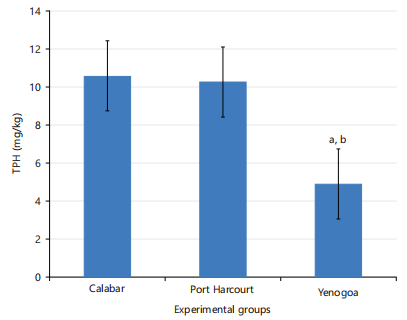
|
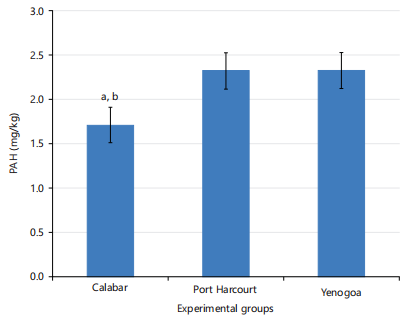
|
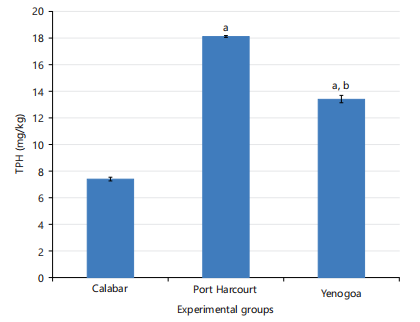
|
Harcourt and Yenogoa are presented in Fig. 5 and 6. As shown in Fig. 5, the mean total petroleum hydrocarbon levels in soup from Calabar, Port Harcourt and Yenogoa were 19.66±0.07, 12.35±0.07 and 18.49±0.03, respectively. From these results, there was a significant increase (p<0.05) in mean TPH levels of soup from Calabar compared to Port Harcourt and Yenogoa. Also, TPH level in soup obtained from Yenogoa was significantly higher (p<0.05) than Port Harcourt, as seen in Fig. 5. Moreover, the mean polycyclic aromatic hydrocarbon levels in soup from the three cities are 2.96±0.04, 1.99±0.08 and 0.82±0.01 for Calabar, Port Harcourt and Yenogoa, respectively. From these results, there was a significant increase (p<0.05) in mean PAH levels of soup from Calabar compared to Port Harcourt and Yenogoa. Also, PAH level in soup obtained from Port Harcourt was significantly higher (p<0.05) than Yenogoa, as seen in Fig. 6.

|
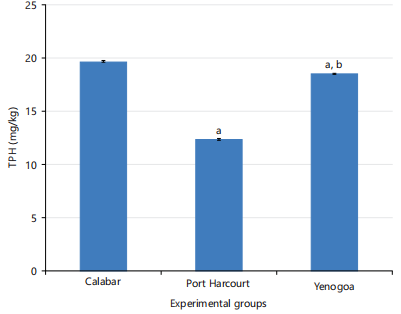
|
Mean total petroleum hydrocarbon (TPH) and polycyclic aromatic hydrocarbon (PAH) levels in snacks from Calabar, Port Harcourt and Yenogoa: The results of the mean total petroleum hydrocarbon (TPH) and polycyclic aromatic hydrocarbon (PAH) levels in snacks from Calabar, Port Harcourt and Yenogoa are shown in Fig. 7 and 8. The results showed that the mean total petroleum hydrocarbon level in snacks from the three cities were 14.33±0.23, 22.08±0.02 and 11.03±0.02 for Calabar, Port Harcourt and Yenogoa, respectively. From these results, there was a significant increase (p<0.05) in mean TPH level of snacks from Port Harcourt when compared to Calabar and Yenogoa. Also, mean TPH level of snacks from Calabar was significantly higher (p<0.05) when compared Yenogoa, as seen in Fig. 7. Also, the mean polycyclic aromatic hydrocarbon level in snacks from the three cities were 4.01±0.01, 11.08±0.06 and 3.97±0.06 for Calabar, Port Harcourt and Yenogoa, respectively. From these results, there was a significant increase (p<0.05) in mean PAH level of snacks from Port Harcourt when compared to Calabar and Yenogoa, as seen in Fig. 8.

|
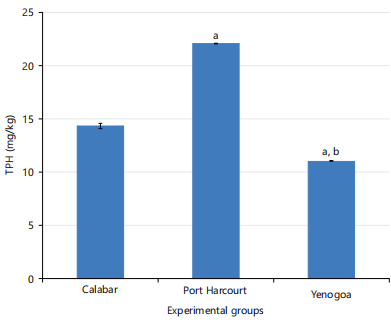
|
DISCUSSION
Most times the ready-to-eat-foods sold around the traffic-congested areas are often exposed to different kinds of environmental contaminants. This study assessed the level of some contaminants (including total hydrocarbon, polycylic aromatic hydrocarbons, some metals and microorganisms) in some ready-to-eat-foods (including roasted plantain, rice and stew, melon soup and meat pie snacks) in some traffic-congested areas in three capital cities in South-South region of Nigeria (including Calabar, Port Harcourt and Yenagoa). The results of this study showed that the levels of some hydrocarbon contaminants in roasted plantain, rice and stew, soup and snacks sold at the major traffic-congested areas in Calabar, Port Harcourt and Yenagoa varied with the food type and city of collection.
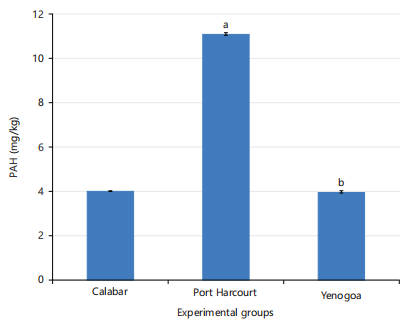
|
The report also indicated that oil exploration activities contribute to high levels of increased toxic heavy metal pollution in the air, waters and soils, within the Niger Delta Region of Nigeria5. The presence of these contaminants in the foods, to a greater extent, supports the existence of a positive correlation between air pollution and food contaminations reported by Ghorani-Azam et al.6 and Tambekaret et al.7. It is therefore possible for this increase in the level of toxic metals in the air, water and soils to have a resultant increase in the uptake and deposition of these metals in foods8,9. Also, the detection of environmental contaminants in some of the ready-to-eat foods sold in Nigeria may be attributed to the fact most of these foods are not well packaged before they are displayed along the sides of the roads10. It is therefore a great concern that these contaminants may have a serious health effect on the consumers.
CONCLUSION AND RECOMMENDATIONS
The study concluded that the quality of most RTEFs vendors in our traffic-congested areas in the cities is not safe. Thereby leaving cause for serious public health concerns in food safety. Hence, various regulatory agencies should carefully monitor the environmental contaminant levels of food in circulation from time to time to ascertain and control the incidence of environmental contaminants toxicity from the ready-to- eat foods in the society. The relevant authorities should make sure that foods sold in major traffic-congested areas in our cities are not exposed to environmental contaminants. The public should be educated about the dangers of patronizing foods sold in major traffic-congested areas in our cities. There should be regular quality assessment and assurance of meals sold around the major traffic-congested areas in our cities at both State and National levels by the Public Health Department of the Ministry of Health. The National Agency for Food and Drug Administration and Control (NAFDAC) should organize seminars regularly to educate people on the dangers posed by most environmental contaminants in foods.
SIGNIFICANCE STATEMENT
Hawking of food products in traffic-congested areas and around petrol stations has been a common practice in several cities. An estimate 2.5 billion people had been reported to patronize RTE food-vendors worldwide. The consumption of street foods, including the RTE foods, has been suggested to potentially increase the risk of contamination. Petrol stations receive a lot of patronage and most times with long queues and constant influx of customers. Therefore, RTEF sellers utilize this opportunity set up open restaurants around and within these areas to sell various edible products. There is a possibility of contamination of foods sold around and within the petrol stations and traffic-congested areas hydrocarbons and other forms of contaminants.
REFERENCES
- Oje, O.J., V.A. Ajibade, O.T. Fajilade and O.A. Ajenifuja, 2018. Microbiological analysis of ready-to-eat (RTE) foods vended in mobile outlet catering units from Nigeria. J. Adv. Food Sci. Technol., 5: 15-19.
- Park, S.K., M.S. O'Neill, P.S. Vokonas, D. Sparrow and R.O. Wright et al., 2008. Air pollution and heart rate variability: Effect modification by chronic lead exposure. Epidemiology, 19: 111-120.
- Nwaichi, E.O., P. Agbam and P.I. Iwu, 2017. Polycyclic Aromatic Hydrocarbons (PAHs) and some trace metals in yam, cassava, orange and papaya from two oil and gas flaring impacted communities in southern Nigeria. J. Appl. Sci. Environ. Manage., 21: 1057-1062.
- Clarence, S.Y., C.N. Obinna and N.C. Shalom, 2009. Assessment of bacteriological quality of ready to eat food (Meat pie) in Benin City Metropolis, Nigeria. Afr. J. Microbiol. Res., 3: 390-395.
- Tambekar, D.H., V.J. Jaiswal, D.V. Dhanorkar, P.B. Gulhane and M.N. Dudhane, 2008. Identification of microbiological hazards and safety of ready-to-eat food vended streets of Amravati City, India. J. Appl. Biosci., 7: 195-201.
- Ghorani-Azam, A., B. Riahi-Zanjani and M. Balali-Mood, 2016. Effects of air pollution on human health and practical measures for prevention in Iran. J. Res. Med. Sci., 21.
- Tambekar, D.H., V.J. Jaiswal, D.V. Dhanorkar, P.B. Gulhane and M.N. Dudhane, 2008. Identification of microbiological hazards and safety of ready-to-eat food vended in streets of Amravati City, India. J. Appl. Biosci., 7: 195-201.
- Udosen, G.E., F.E. Uboh, D. Amaechi, M.O. Odey and J.E. Mgbang, 2019. Risk assessment of heavy metal contaminants in some common ready to eat meals sold at petrol stations in Calabar Metropolis. Asian J. Res. Nurs. Health, 2: 15-20.
- Udosen, G.E., F.E. Uboh, D. Amaechi, M.O. Odey and J.E. Mgbang, 2019. Evaluation of the concentrations of some heavy metals (Pb, Cd and Cr) and long term exposure due to daily consumption of ready-to-eat foods sold at petrol station’s atmospheric conditions (AF) in Calabar Metropolis. Asian Food Sci. J., 9.
- Mahakarnchanakul, W., W. Ontoum, S. Stonsaovapak, N. Pirapatrungsuriya, P. Choo-In and T. Borisuit, 2010. Risk evaluation of popular ready-to-eat food sold in Bangkok. Asian J. Food Agro-Ind., 3: 75-81.
How to Cite this paper?
APA-7 Style
Udosen,
G.E., Bassey,
S.O., Amaechi,
D., Udom,
I.U., Ime,
A. (2024). Determination of TPH and PAH Contaminants Levels in Selected Ready-To-Eat Foods in Southern Nigeria. Asian Science Bulletin, 2(4), 509-516. https://doi.org/10.3923/asb.2024.509.516
ACS Style
Udosen,
G.E.; Bassey,
S.O.; Amaechi,
D.; Udom,
I.U.; Ime,
A. Determination of TPH and PAH Contaminants Levels in Selected Ready-To-Eat Foods in Southern Nigeria. Asian Sci. Bul 2024, 2, 509-516. https://doi.org/10.3923/asb.2024.509.516
AMA Style
Udosen
GE, Bassey
SO, Amaechi
D, Udom
IU, Ime
A. Determination of TPH and PAH Contaminants Levels in Selected Ready-To-Eat Foods in Southern Nigeria. Asian Science Bulletin. 2024; 2(4): 509-516. https://doi.org/10.3923/asb.2024.509.516
Chicago/Turabian Style
Udosen, Grace, Esua, Stella Oyom Bassey, Dennis Amaechi, Idorenyin Uboho Udom, and Akaninyene Ime.
2024. "Determination of TPH and PAH Contaminants Levels in Selected Ready-To-Eat Foods in Southern Nigeria" Asian Science Bulletin 2, no. 4: 509-516. https://doi.org/10.3923/asb.2024.509.516

This work is licensed under a Creative Commons Attribution 4.0 International License.




